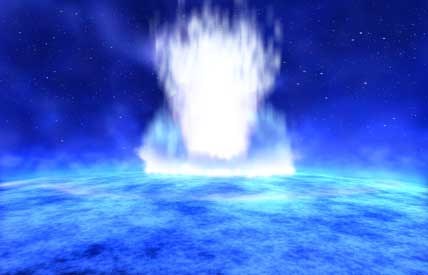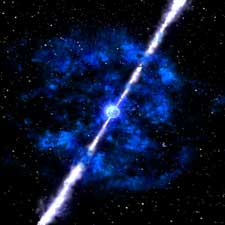
In this artist's conception, a jet of particles shoots out of a massive star at near-light speed. Generated by a newborn black hole in the doomed star's just-collapsed core, the jet will generate a gamma-ray burst if it points toward Earth.
Courtesy NASA, Dana Berry, and SkyWorks Digital.
It hasn't been an easy ride for the High-Energy Transient Explorer, or HETE-2. Its older brother, HETE-1, was lost in 1996 when a Pegasus rocket failed to release the spacecraft after carrying it into Earth orbit. HETE-2 was cobbled together using spare parts and finally was launched in October 2000 — only to spend its first year ironing out bugs in its onboard software and Earth-girdling ring of data-receiving stations.
But back-to-back press conferences this past week made it clear that the long wait has paid off for aficionados of gamma-ray bursts (GRBs), brief flashes of penetrating radiation that appear without warning at random points on the sky. Last year HETE-2 helped to guide telescopes across the globe and in space to several GRBs — often within minutes — and the resulting data are helping cement the already suspected link between the mysterious bursts and the death throes of massive stars.
GRBs take place in galaxies billions of light-years from Earth. They appear to be associated with core-collapse supernovae: the sudden explosions that ensue when massive stars abruptly exhaust their central reserves of nuclear fuel. And they may herald the births of black holes in those stars' collapsed cores.

How the visible-light afterglows of the three best-observed gamma-ray bursts behaved early on. GRB 021004 stands apart by barely fading during its first 3 hours. Note that the time axis is logarithmic.
S&T illustration. Source: Derek Fox (Caltech).
Last Wednesday, Derek W. Fox (Caltech) explained how HETE-2 enabled his research team to assemble the best light curve yet for a GRB's visible afterglow. On October 4, 2002, HETE-2 pinpointed a strong gamma-ray burst in the constellation Pisces. Aided by an Internet-based alert system, amateur and professional astronomers worldwide measured the brightness of a fading "star" at the burst's position. Two other closely studied GRB counterparts faded rapidly from the get-go, but the light streaming from GRB 021004, as the October 4, 2002, burst is known, "barely decayed for two hours," Fox explained. The implication? "The burst was being provided with new energy" throughout that time period.
And that, says HETE-2 principal investigator George R. Ricker (Massachusetts Institute of Technology), "lends validity to the collapsar picture," in which a massive star's core collapses, forming a magnetized black hole. The magnetized black hole then channels some of the star's envelope into narrow jets that fly out in opposite directions at near-light speed. One of those jets produces a gamma-ray burst if it happens to point Earthward, and it later creates visible light when it smashes into surrounding material. GRB 021004's sustained visible-light glow suggests that the black hole was fueled for an extended period.

The jets emerging from a GRB progenitor smash into surrounding material, and shocks within both the jets and the surroundings generate light that can be seen billions of light-years away.
Courtesy NASA, Dana Berry, and SkyWorks Digital.
Close on the heels of Fox's announcement was Monday's press conference in Mont Tremblant, Canada, where the High Energy Astrophysics Division of the American Astronomical Society is holding its biannual meeting. There, MIT astronomer Nathaniel R. Butler described how the Chandra X-ray Observatory probed another GRB that HETE-2 pinpointed last August 13th. That burst, GRB 020813, sprinkled Chandra with X-rays, some of which bunched up at two distinct frequencies. According to Butler, those fine-tuned X-ray emission lines came from ions of silicon and sulfur — chemical elements expected in the detritus of a supernova explosion.
The silicon and sulfur ions Butler discovered in GRB 020813 lay in a shell that already was several light-days across, even though the burst itself was only one day old when Chandra began its observation. Because the ions appeared to be rushing away from the scene of the explosion at "only" one-tenth the speed of light, the supernova likely took place weeks before the gamma-ray burst. This suggests that the August 13th burst was spawned in a so-called supranova, where a collapsing massive star blasts off its envelope, supernova-style, but something temporarily prevents the star's core from forming the jet-spewing black hole that later powers the GRB. Butler's finding "is substantially the strongest piece of evidence" for the supranova model, said University of Chicago theorist Donald Q. Lamb at yesterday's press conference, but he admits that the evidence remains circumstantial.
 0
0
Comments
You must be logged in to post a comment.